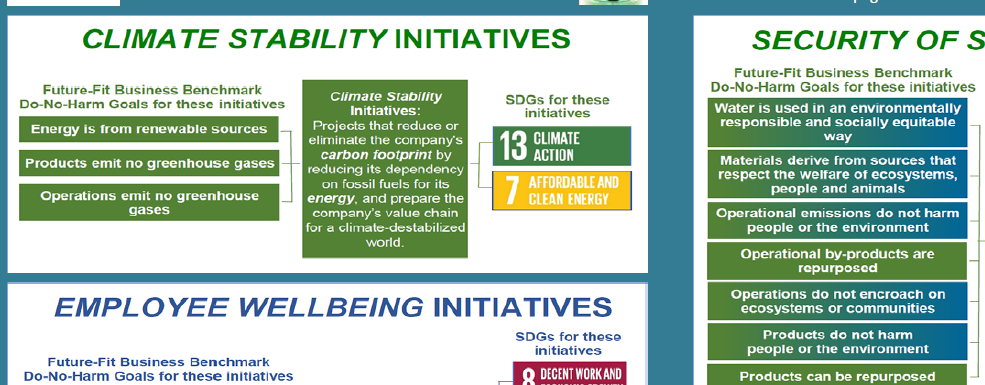Sustainability Advantage – Future-Fit Business Benchmark

Projects Sponsor
Taking the Washing out of GreenWashing
Increasingly words like “earth-friendly” and “green” are pasted onto to just about anything like so many brightly coloured stickers onto fruit. The prefixes “enviro” and “eco” are tossed about like disposable stir sticks at a roadside coffee shop with no recycling bin. This is confusing to the well-intentioned consumer and the bigger picture that of the actual players, is often not much clearer.
Defining what exactly being a “sustainable” company means and recognizing a sustainable company when we see it have become increasingly important, not just to the governments, organizations and individuals who rightly seek the reward, promote and patronize those enterprises, but to the companies themselves.
The business case for adopting sustainability strategies gets stronger and stronger by the day, but without clear standards by which a company can measure its performance vis-à-vis its environmental impact, these gains are far more difficult to realize.
Enter the “Gold Standard” project, launched in 2012 by Bob Willard with The Natural Step Canada. The Gold Standard aim was to define a science-based set of environmental and social do-no-harm goals and to set a benchmark that will help ensure a company is positioned to thrive in the future.
In 2013 Gold Standard was joined by kindred spirits in Britain and the project was renamed the “Future-Fit Business Benchmark.” The Future-Fit Foundation, led by Geoff Kendall, was established to manage and steward the project through to completion.
A year was spent determining the best-available science on which to base the necessary environmental and social goals needed to establish a benchmark. The team concluded that the eight system conditions set down by The Natural Step embodied the best-available science. After that they set out to define the eight business principles that best reflect those conditions necessary for a sustainable human civilization on our finite planet and the key fitness indicators that would help a company measure its progress on the goals in both its own operations and its supply chain were laid out.
The document was then made available for public comment and for review by an expert release council. The do-no-harm Release 1 of the benchmark was published in May 2016. By the end of 2017, the Future-Fit Foundation will launch Release 2 which will include do-some-good goals.
This venture marks the first time a science-based definition of a truly sustainable company has been set down. Previously a company could measure their performance against their performance in previous years, determine whether the company is on track to meet its short-term goals, and look at their performance relative to that of other companies.
What Future Fit provides to organizations and industries is a vital fourth benchmark, allowing companies not ask not just “Are we doing better than before?” or “Are we doing better than those guys?” but “How exactly are we doing?”.
This metric puts a stake in the ground marking exactly where a company needs to be on each of its goals. Knowing how much is enough and how much farther and in what direction they will need to move in order to reach a clear set of science-based sustainability performance targets is how they’re going to get to where they absolutely have to go.













